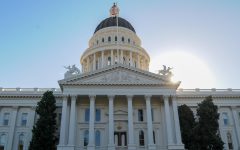
Voter at polls during presidential election, using paper ballots. (Photo: Rob Crandall/Shutterstock)
California’s Local Elections Procedures
All statewide special elections to be called, conducted, and canvassed
By Chris Micheli, February 13, 2022 8:43 am
California’s Elections Code provides numerous rules for local and consolidated elections in Division 10. Part 1 deals with General Provisions and Chapter 1 deals with Voters and Procedure. Section 10000 provides that every person is entitled to vote at a local, special, or consolidated election who is registered in any one of the precincts which compose the local, special, or consolidated election precincts.
Section 10001 requires all statewide special elections to be called, conducted, and canvassed as provided by this code for the calling, conducting, and canvassing of general elections.
Section 10002 provides that the governing body of any city or district may by resolution request the board of supervisors of the county to permit the county elections official to render specified services to the city or district relating to the conduct of an election. Subject to approval of the board of supervisors, these services are to be performed by the county elections official.
Any city that requests the board of supervisors to permit the elections official to prepare the city’s election materials is required to supply, if the board of supervisors agrees to provide such services, the county elections official with a list of its precincts no later than 61 days before the election. The city or district is required to reimburse the county in full for the services performed upon presentation of a bill to the city or district.
Section 10004 specifies that, if the governing body of any special district fails to call or to take any other steps necessary to the holding of the regular district election at which any member or members of the governing body of the district are to be selected, the board of supervisors of the county in which the district is located may call a special election within the district for the selection of the governing board member or members involved.
The election is required to be held not later than 90 days after it is called by the board of supervisors, and must be conducted in the same manner as the regular district election. The costs of the special election are borne by the district for which the election is held.
Chapter 2 of Part 1 deals with District Boundaries. Section 10010 provides that a political subdivision that changes from an at-large method of election to a district-based election, or that establishes district-based elections, is required to do all of the following before a public hearing at which the governing body of the political subdivision votes to approve or defeat an ordinance establishing district-based elections:
- Before drawing a draft map or maps of the proposed boundaries of the districts, the political subdivision is required to hold at least two public hearings over a period of no more than 30 days, at which the public is invited to provide input regarding the composition of the districts.
- After all draft maps are drawn, the political subdivision must publish and make available for release at least one draft map and, if members of the governing body of the political subdivision will be elected in their districts at different times to provide for staggered terms of office, the potential sequence of the elections.
In determining the final sequence of the district elections conducted in a political subdivision in which members of the governing body will be elected at different times to provide for staggered terms of office, the governing body is required to give special consideration to the purposes of the California Voting Rights Act of 2001 and is required to take into account the preferences expressed by members of the districts.
This section defines the terms “at-large method of election,” “district-based election,” and “political subdivision.” A prospective plaintiff is required to send by certified mail a written notice to the clerk of the political subdivision against which the action would be brought asserting that the political subdivision’s method of conducting elections may violate the California Voting Rights Act of 2001.
A political subdivision may pass a resolution outlining its intention to transition from at-large to district-based elections, and the specific steps it will undertake to facilitate this transition, and an estimated timeframe for doing so.
The plaintiff and political subdivision may enter into a written agreement, and the political subdivision is required to prepare and make available on its internet website a tentative schedule of the public outreach events and the public hearings held pursuant to this section.
If a political subdivision does not maintain an internet website, the political subdivision shall make the tentative schedule available to the public upon request. There are detailed rules for prospective plaintiffs and district-based elections.
- General Provisions of California’s LLC Act - January 10, 2026
- Interpretation of Arbitration for International Disputes - January 9, 2026
- Uniform Partnership Act in California - January 9, 2026




